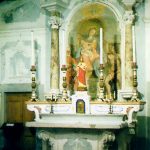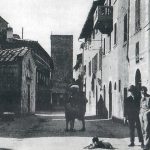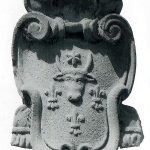The confraternity, founded in 1419, established its headquarters in a small church located in the northern part of the walled village, possibly the one that had formerly belonged to the ‘popolo’ from Santa Maria in Mongibello. In 1420, it was granted to the Confraternity of the Holy Cross, which had been founded in 1419.
The headquarters of this Confraternity was rebuilt in 1574, and by the early 17th century, there were three altars. In the first half of the 18th century, we know that the miraculous Crucifix was placed on the main altar—still existing today—(now located at the Propositura of Saints Hippolytus and Cassian). The altar on the right was dedicated to Saint Anthony of Padua, while the one on the left was dedicated to the Nativity of Mary.
Suppressed by Pietro Leopoldo in 1785, the oratory became private property and was later purchased by the Ginori family, then passed to the Sloane family, and subsequently to the Boutourline family. In 1885, Count Augusto, owner of the Isola estate, donated it to the New Confraternity of the Blessed Sacrament and the Crucifix, which had been re-established in 1793 and held its meetings in the church of San Biagio. Although restored in 1888, the building was rarely used for the confraternity’s meetings, which continued to gather at San Biagio. In 1913, it was granted to the Catholic Society. Currently used as a storage facility, it is not open to visitors.
The Romanesque church of San Biagio has a single nave, covered with a gabled roof, and a presbytery separated by an arch.
The main altar, with two composite marble columns and a curved and broken stucco pediment, dates back to 1774. At the center is a fresco depicting the Madonna enthroned with the Child, surrounded by Saints Sebastian and Biagio, which can be dated to the 16th century but was restored in 1630. (“OB HONOREM / ANNO DOMINI MDCXXX SANCTI BLASII BEATISSIMAEQUE / VIRGINIS MARIAE / SOCIETAS CORPORIS CHRISTI RESTAURANDUM CURAVIT”).
Above, inside the pediment, there are elegant 18th-century stuccoes featuring the symbol of the Blessed Sacrament, while on either side are allegories of Faith and Hope, also depicted in stucco bas-relief.
The left lateral altar, dedicated to Saint Bartholomew, bears the coat of arms of the Busatti family, who built it in 1614 and were its patrons. It features an image of the Madonna enthroned between Saints John the Baptist, Bartholomew, and Biagio, a contemporary work. However, the altar was rebuilt in 1699.
In the right niche, there is a late 18th-century fresco, not very legible, possibly depicting the Naming of Saint John the Baptist or the Presentation of Mary at the Temple, with a Saint Jerome and Saint Francis on the sides, and God the Father in the tympanum.
The decoration of the oratory is completed by a 17th-18th century canvas depicting Mary Magdalene, Saints Peter, John the Baptist, and Bartholomew, which was originally part of the late 17th-century Busatti altar.
After the suppression of the Confraternity in 1785, the oratory was granted to the New Confraternity of the Blessed Sacrament and the Crucifix for their meetings. It was restored several times (1795, 1847, 1860).






